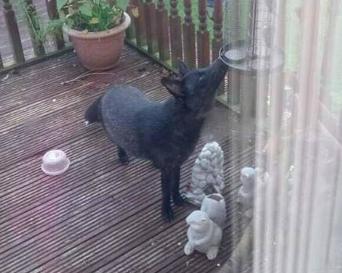
For the Sake of the Silver Fox
Black Foxes UK works to ensure silver fox welfare by collaborating with organisations and individuals who share our desire to create an informed community that promotes awareness of the issues faced by this complex species.
What Are We Fundraising For?
Equipment and Costs to Run Education and Community Outreach Events
Despite the ban on fur farming in the UK in 2000, London remains the world center for fur buyers, in a trade that produces over 15 million fox pelts a year. On top of the legal trade in fur (which can be found in many regular high street stores in the UK today), there is a vast amount of mislabeled "faux fur" from China. So much so, that in 2018, there was an unsuccessful campaign to ban the trade of fur in the UK altogether.
Animal welfare organisations, such as the RSPCA and BVZS, also report an increasing amount of exotic pets requiring their assistance each year, which includes silver foxes.
We believe that educated consumers make educated choices. With equipment and funds to organise and run education events, Black Foxes UK aim's to promote awareness of animal welfare topics relating to the silver fox and it's commercial production by providing the information consumers need in order to make informed choices and to prevent impulse purchases.

Resolving Taxonomic Confusion & Raising Awareness of Threatened Status
Prior to 1959, the North American red fox was considered a separate species to the European red fox (previously vulpes fulva now considered vulpes vulpes) and it's presence in North America is honoured by the native American Indian folklore that existed prior to European settlement.
In 2011, new genetic technology was able to confirm that the original classification of the North American red fox as a separate species was likely to have been correct. After 400,000 years of isolation, the North American red fox has become a divergent species, possessing genetic and phenotypical differences not seen in the European red fox, such as:
- 3 statistically predictable colour variations (red, cross and silver)
- fuller coats with longer, silkier guard hairs
- longer hind limbs and thicker furred paws
All adaptations that allow a fox to survive in the sub-arctic tundra of North America. Adaptations that also made the species a good candidate for commercial fur trade.
Our mis-classification of the North American red fox as the same species as the European red fox led to the species being considered invasive or introduced in the US. New studies reveal that the wild North American red fox (Sierra Nevada red fox, Cascades red fox and the Rocky Mountain red fox) is a threatened species today and calls are being made to protect these rare foxes, before it is too late.
Many aren't aware these foxes exist and new information takes time to reach the wider population, time these foxes do not have. Education is vital for their continued survival, we cannot protect what we do not know exists.
Costs of Neutering Silver Foxes in Need
Reaching sexual maturity is one of the main reasons silver foxes escape and are re-homed. Non-neutered silver foxes have a naturally strong desire to follow the "call of the wild" - which increases undesirable behaviours such as urine marking, seasonal aggression and the desire to roam. Seasonal hormonal changes also increases the potency of reproductive hormones and pheromones, which can attract unwanted attention from wild foxes.
Preventing silver foxes from breeding has many benefits, including:
- Reducing Re-homing - Neutered silver foxes are much less likely to develop the unwanted and undesirable behaviours related to sexual maturity and breeding that often results in the need for re-homing.
- Preventing Inbreeding - Non-neutered silver foxes will readily breed with siblings if they are not separated and correctly secured during the breeding season, which can result in unwanted pregnancies and inbred litters.
- Preventing Hybridisation - Non-neutered silver foxes will readily attempt to escape and breed with native wild foxes if they are not correctly secured during the breeding season, which can result in unwanted, hybrid litters.
- Controlling Overpopulation - Neutered animals cannot breed and contribute to the problems associated with unwanted litters and exotic pet overpopulation.
With funds available to cover neutering costs, Black Foxes UK can help to control the risks associated with inbreeding, pet overpopulation, naturalisation and hybridisation by directly financing the neutering costs of rescued silver foxes and silver foxes in need.
Disclaimer: Every anaesthetic and surgical procedure carries a small risk of complications. Neutering is a routine procedure, the risks of which are known and minimised. Animals in season or animals that could potentially be pregnant are at a higher risk of complications. For this reason, it is usually advised neutering is postponed until 12 weeks after a season, (silver foxes come into season 3 days a year - between late December and early February). However, animals in season or animals that are pregnant are also at a higher risk of complications as a result of unwanted pregnancy or potential escape, so this must be taken into account when taking the decision to neuter.
Costs of Fostering and Re-homing Silver Foxes in Need
There are few resources available for keepers of exotic pets, which can make it difficult for those seeking to re-home a silver fox in need. Locating a suitable new home for a silver fox can be a time-consuming and frustrating process, which can be a risk to welfare under certain circumstances (such as in cases where aggression, escape or mating behaviours are involved).
Funds raised will be used to cover the costs to continue our work, which involves:
- locating suitable, knowledgeable homes
- performing home-checks
- providing animal transportation
- covering the costs of veterinary health checks
In providing a dedicated foster and re-homing service, Black Foxes UK can protect the welfare of silver foxes by fostering and re-homing animals in need before escape, accident or unwanted pregnancy occurs, and by providing vetted, knowledgeable forever homes.

Equipment and Costs to Recapture Lost Exotic Pets
Black Foxes UK receives an increasing amount of melanistic and anomalous red fox reports every year, with over 200 sightings logged with us since we began recording in 2015. While many of the reports are of unconfirmed sightings, the majority of confirmed sightings have proved to be that of missing silver foxes, rather than wild melanistic animals. Animals raised in captivity do not have the skills to exist in the wild and sadly, several lost silver foxes have not survived long enough to be located and recaptured.
Catching and containing exotic pets like silver foxes is not an easy task and many animal welfare organisations do not have the skills, knowledge or resources to deal with such a situation. Black Foxes UK has already assisted in the location and recapture of several missing silver foxes, but we would like to do so much more to assist foxes and their keepers.
The funds raised will be used to purchase:
- Humane fox traps
- Animal handling gloves and protective sleeves
- Catch nets
- Herding boards
- Travel and transport costs
- Veterinary services and treatment (where necessary)
- Temporary holding enclosures
With our team members fully equipped with the necessary tools, they will be much more able to assist in the safe and efficient capture of every lost or abandoned silver fox reported to us.

Equipment and Resources to Conduct Citizen Science Projects
The North American red fox was introduced into the UK in the early 1900's with the start of the commercial fox farming industry. Despite the ban on fur farming in 2000, the North American farmed fox or "silver fox" continues to be bred in the UK today. Black Foxes UK aims to establish what degree of coat colour variation is seen naturally within the UK fox population, as well as to investigate the extent of any possible hybridisation with North American foxes as a result of escapes and releases.
In order to achieve this goal:
- The scope and capacity of our sighting and reporting system must be increased
- Development of a detailed research program is needed
- Membership and collaboration with the National Biodiversity Network must be maintained
- Development of a private members fox conservation working group
- Support of universities and research establishments must be enlisted through fundraising grant provisions
2024 Campaign Update - Current Status
In July 2019 we attempted to launch our organisation as a Community Interest Company (CIC), Black Foxes UK CIC, Company Number 12106036, which officially began trading in September 2019 with the sale of fox-themed online products and services, provided through our website and with the future aim of selling online courses in silver fox management, which we hoped would be able to fund our campaign aims.
By March 2020, the Covid pandemic was formally kicking off and there was a very real risk of animal rescues and collections having to close and our original business model was no longer looking sustainable. The development of the silver fox management course was put on hold. Upon submitting our first accounts, it became clear there was an issue with the HMRC online platform and we were unable to submit any information. Calls to HMRC's service during the pandemic took extensive amounts of time and those we spoke to did not know how to resolve the issue we were having.
In July 2021, encountering the same problem, HMRC was contacted again. Despite contacting them several times over a period of months, the platform issue could not be resolved and it was decided that it would be best to close the business as a CIC and to develop a new plan to support our aims, we had assumed this had occurred. The business was not deemed gainful during the period of its operation.
In July 2024, it became clear that the update of the accounts and the closure of the business had not been completed and access to the system to submit any information is still not possible. HMRC were contacted again and went through the login process with us to ensure we were completing it accurately, and we were still unable to submit any information. HMRC have assured us that these issues will be resolved and the business is now closed, we are currently awaiting their written notification of confirmation. Online records will be updated in due course.
Black Foxes UK aims to continue as an unincorporated organisation (as we existed before registering as a CIC), but to do that, we require much more input and support from the community. Our operations today continue as they started, through the donation of personal resources by our members, in order to support our common cause.
If you would like to become a member, please see the links below:
Copyright 2015 Black Foxes UK